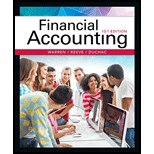
Financial Accounting
15th Edition
ISBN: 9781337272124
Author: Carl Warren, James M. Reeve, Jonathan Duchac
Publisher: Cengage Learning
expand_more
expand_more
format_list_bulleted
Concept explainers
Question
Chapter 12, Problem 5DQ
To determine
Explain if Mr. M is risking nothing.
Expert Solution & Answer
Want to see the full answer?
Check out a sample textbook solution
Students have asked these similar questions
I want to correct answer general accounting question
Need help with this question solution general accounting
Give me answer please
Chapter 12 Solutions
Financial Accounting
Ch. 12 - Prob. 1DQCh. 12 - Prob. 2DQCh. 12 - Prob. 3DQCh. 12 - Prob. 4DQCh. 12 - Prob. 5DQCh. 12 - Prob. 6DQCh. 12 - Prob. 7DQCh. 12 - Prob. 8DQCh. 12 - Prob. 9DQCh. 12 - Prob. 10DQ
Ch. 12 - Prob. 1PEACh. 12 - Prob. 1PEBCh. 12 - Prob. 2PEACh. 12 - Prob. 2PEBCh. 12 - Prob. 3PEACh. 12 - Prob. 3PEBCh. 12 - Prob. 4PEACh. 12 - Prob. 4PEBCh. 12 - Prob. 5PEACh. 12 - Liquidating partnerships Prior to liquidating...Ch. 12 - Prob. 6PEACh. 12 - Prob. 6PEBCh. 12 - Revenue per employee Niles and Cohen, CPAs earned...Ch. 12 - Prob. 7PEBCh. 12 - Prob. 1ECh. 12 - Prob. 2ECh. 12 - Prob. 3ECh. 12 - Prob. 4ECh. 12 - Prob. 5ECh. 12 - Prob. 6ECh. 12 - Prob. 7ECh. 12 - Prob. 8ECh. 12 - Prob. 9ECh. 12 - Prob. 10ECh. 12 - Prob. 11ECh. 12 - Prob. 12ECh. 12 - Prob. 13ECh. 12 - Prob. 14ECh. 12 - Prob. 15ECh. 12 - Prob. 16ECh. 12 - Statement of members equity, admitting new member...Ch. 12 - Distribution of cash upon liquidation Hewitt and...Ch. 12 - Distribution of cash upon liquidation David Oliver...Ch. 12 - Liquidating partnershipscapital deficiency Lewis,...Ch. 12 - Prob. 21ECh. 12 - Prob. 22ECh. 12 - Statement of partnership liquidation After closing...Ch. 12 - Prob. 24ECh. 12 - Prob. 25ECh. 12 - Revenue per professional staff The accounting firm...Ch. 12 - Prob. 27ECh. 12 - Prob. 1PACh. 12 - Prob. 2PACh. 12 - Prob. 3PACh. 12 - Prob. 4PACh. 12 - Statement of partnership liquidation After the...Ch. 12 - Prob. 6PACh. 12 - Prob. 1PBCh. 12 - Prob. 2PBCh. 12 - Prob. 3PBCh. 12 - Prob. 4PBCh. 12 - Statement of partnership liquidation After the...Ch. 12 - On August 3, the firm of Chapelle, Rock, and Pryor...Ch. 12 - Prob. 1CPCh. 12 - Prob. 3CPCh. 12 - Prob. 4CP
Knowledge Booster
Learn more about
Need a deep-dive on the concept behind this application? Look no further. Learn more about this topic, accounting and related others by exploring similar questions and additional content below.Similar questions
arrow_back_ios
SEE MORE QUESTIONS
arrow_forward_ios
Recommended textbooks for you
 College Accounting, Chapters 1-27 (New in Account...AccountingISBN:9781305666160Author:James A. Heintz, Robert W. ParryPublisher:Cengage Learning
College Accounting, Chapters 1-27 (New in Account...AccountingISBN:9781305666160Author:James A. Heintz, Robert W. ParryPublisher:Cengage Learning


College Accounting, Chapters 1-27 (New in Account...
Accounting
ISBN:9781305666160
Author:James A. Heintz, Robert W. Parry
Publisher:Cengage Learning